Recent Articles
Popular Makes
Body Types
2018 Porsche Panamera Road Test and Review
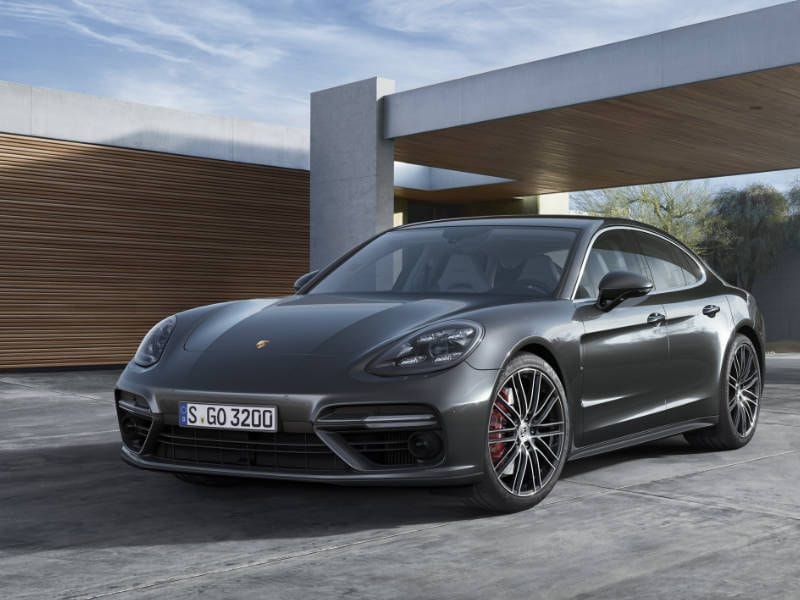
2017 Porsche Panamera hero ・ Photo by Porsche
There are only a handful of four-doors in the world that can top 190 mph, accelerate to 60 mph in under 3.5 seconds and coddle their occupants in extreme luxury. The 2018 Porsche Panamera is one of them. Porsche is best known for its sports cars, most significantly the 911, which has been in production since 1965. But the German carmaker has also been selling SUVs since 2002 and added the Panamera, a four-door hatchback with optional all-wheel drive, in 2010.
Like the rest of Porsche’s highly praised lineup, the 2018 Panamera delivers a unique combination of style, luxury, and performance. Now in its second generation, it’s one of our favorites in the extremely competitive large luxury sedan class, where it competes against the BMW 7 Series, Mercedes-Benz S Class, Audi A7 and A8, and Aston Martin Rapide.
Sixteen Variations to Choose From
For 2018, the Panamera lineup expanded to 14 variations that include two body styles, two wheelbases and six drivetrains including hybrids and all-wheel-drive models. Prices start at $86,050, including $1,050 delivery fee, for the base Panamera, which is a four-door hatchback with the shorter wheelbase. It comes with a 330-horsepower turbocharged 3.0-liter V6 engine, and Porsche says it can sprint to 60 mph in just 5.4 seconds. The Panamera 4 adds all-wheel drive and costs another $4,600, while the 4 Sport Turismo, which adds a more formal station wagon roofline for additional storage space, costs $97,250. The least expensive long-wheelbase model, which is about 6 inches longer, is the $97,350 Executive.
Our all-wheel-drive Panamera 4S test vehicle packed a 440-horsepower twin-turbo 2.9-liter V6 and carried a base sticker price of $104,050. With options, it cost over $130,000. There are also Panamera 4S versions of the Sport Turismo and Executive, 550-horsepower Turbo models of each and plug-in E-Hybrid models of all three, starting at $100,650 and topping out at $189,450 for the 680-horsepower Panamera Turbo S E-Hybrid Sport Turismo. And yes, that’s officially the longest name of any Porsche in history.
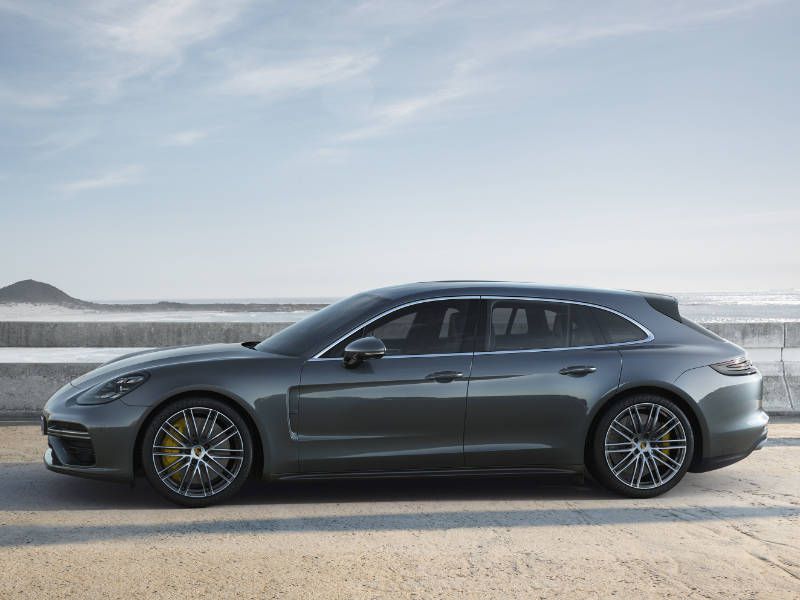
Photo by Porsche
It Looks Expensive
The first-generation Panamera wasn’t exactly beautiful, but it looked expensive and its unique four-door hatchback body style helped usher in the age of the four-door luxury coupe, joined by the Audi A7, BMW 6 Series Gran Coupe and Mercedes-Benz CLS. Today's second-generation Panamera is far more attractive than its predecessor. It looks leaner, lower and longer, and it more closely resembles Porsche's 911 sports car. It’s not radically different than it was before, but the 2018 Panamera's new lines are more elegant and it looks far more youthful and much more athletic than the upright BMW 7 Series and Mercedes-Benz S Class.
For 2018, Porsche has added the Sport Turismo body style, which is distinctive in the marketplace. The Sport Turismo is unique from the B-pillars back and features a longer roof and larger hatch. Americans would call it a wagon, but the term doesn’t do the Panamera Sport Turismo justice. It’s gorgeous and sexy and severe, and it looks like no wagon you’ve ever seen before.
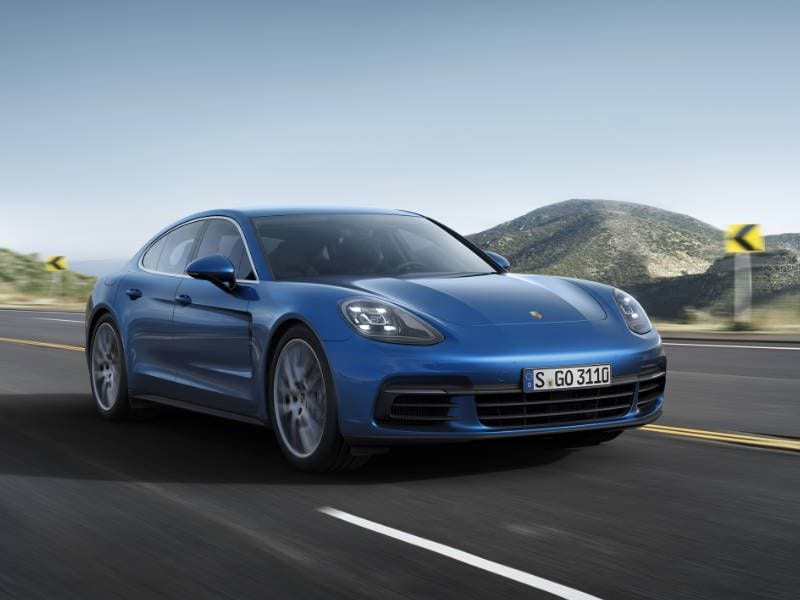
Photo by Porsche
Hot Rod Hybrid
Before we spent a week driving a 2018 Porsche Panamera 4S around Los Angeles, we spent a day in southern Spain driving a Turbo S E-Hybrid Sport Turismo. It’s the ultimate Panamera, the most powerful and the most expensive. It’s also among the greatest cars in the world. Powered by a 550-horsepower twin-turbocharged 4.0-liter V8 in combination with an electric motor and a battery pack, which bring an additional 136 horsepower, it's one of the most powerful four-doors in the world. Use its launch control and the incredible traction of its all-wheel drive and massive 21-inch high-performance tires, and its combined 680 horsepower is enough for 0-60 mph runs of 3.2 seconds. Its top speed is 192 mph.
But incredible speed is only half the story. The powertrain of the Panamera plug-in hybrid is also exceedingly smooth and refined. Recharging takes less than three hours with a 240-volt connection, and its electric motor comes in and out of the propulsion process without you even noticing. Despite its 5,000 pounds of heft, this Panamera also handles like a real Porsche, with sports car agility plus one of the smoothest rides in this class.
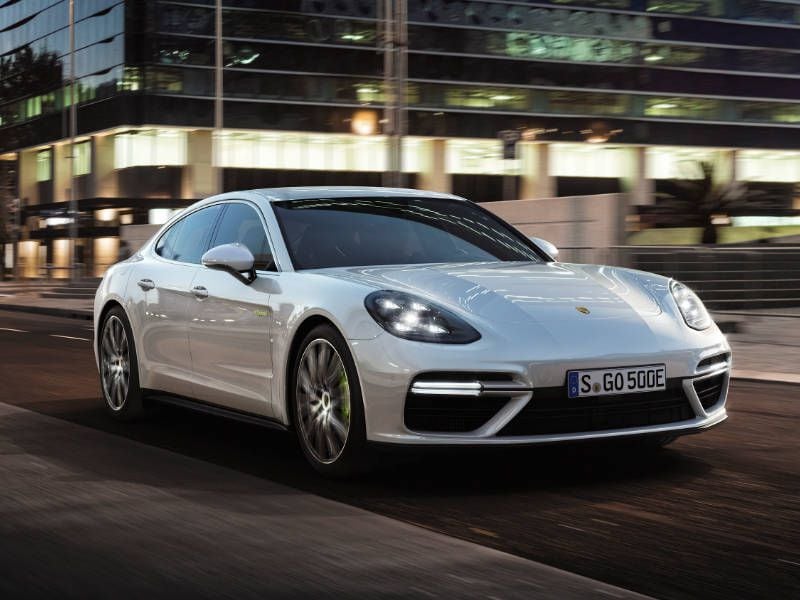
Photo by Porsche
Fast, Fun and Refined
In and around Los Angeles, our test vehicle delivered an inspired combination of luxury and performance. The Panamera is extremely smooth, comfortable and quiet. It feels solid and substantial and rides beautifully. Despite its 20-inch wheels, the adjustable air suspension perfectly isolates passengers from potholes, surface changes and other road irregularities. Most cars that ride this well feel like big, soft blobs, floating over the earth and around corners. They lose their ability to be fun and sporty. Not the Panamera. This is still a Porsche. And the Panamera is a true sports sedan. It’s engaging. And it corners like a car half its size and weight.
Our test car's optional Sport Package added the air suspension, rear axle steering, performance exhaust and the Sport Chrono Package, which adds a Sport Plus Mode. Sport Plus radically increases the Panamera’s throttle response, retunes the transmission and profoundly livens up the driving experience beyond the standard Normal and Sport modes. The twin-turbo V6 is strong and perfectly matched to the quick shifting eight-speed PDK automatic transmission, which is among the best dual-clutch units in the world. It doesn’t accelerate like its Turbo S hybrid sibling, but with 440 horsepower the Panamera 4S is quick enough to run with the more powerful twin-turbo V8-powered Mercedes S 560.
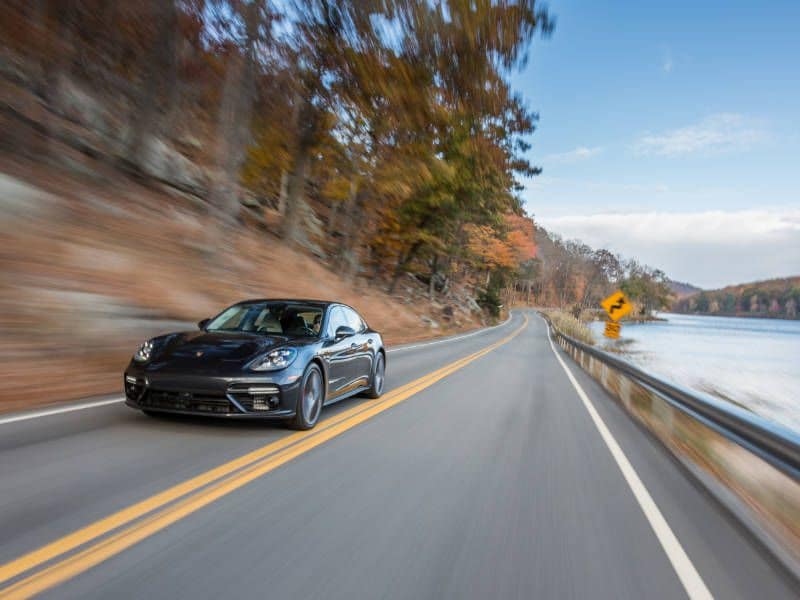
Photo by Porsche
Average Fuel Economy for the Class
Overall, the Panamera’s fuel economy is about average for this class. Incredibly, the base Panamera and the significantly more powerful Panamera S models are both rated for 21 mpg in the city and 28 mpg on the highway. I averaged 22 mpg during a week of mixed driving including a fun few hours exercising the car through the Santa Monica Mountains. I also liberally used the Porsche’s start/stop feature, which shuts off the engine at idle to conserve fuel.
Panamera Turbo models are also surprisingly fuel-efficient considering their 550 horsepower. They're rated for 18 mpg city and 25 mpg highway, which is better than the 463-horsepower Mercedes S 560. The Panamera E-Hybrid has an E-Power mode that allows it to be driven 30 miles on electricity alone. Its overall fuel economy numbers aren’t finalized yet.
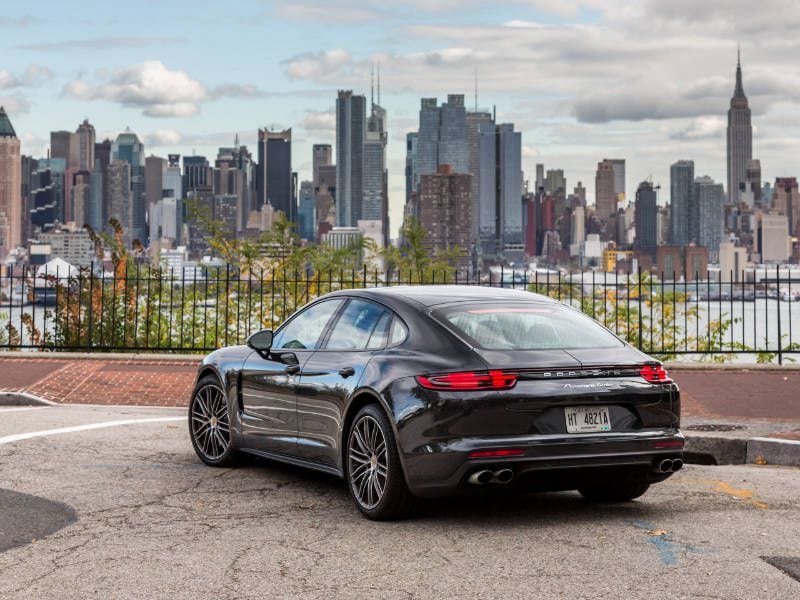
Photo by Porsche
Comfortable, Sporty Interior
You sit low in the Panamera, which adds to the sports-car feel. Visibility is excellent, however, and the driver’s seat is height-adjustable. The dash and wide console are similar to the layouts used in Porsche's sports cars and SUVs, and the overall design works well in the Panamera. It feels upscale, with high build quality and rich materials, but there’s nothing traditional about it. The console is a sea of buttons, which looks complicated but is actually easy to navigate. The Panamera’s massive 12-inch color touchscreen is perfectly placed and quick to respond to inputs, though not as intuitive as it could be. Fortunately, the car includes Apple CarPlay connectivity and onboard Wi-Fi.
The two rear passengers get rear air conditioning vents and a rear console, which offers a couple of cupholders. That’s right, the Panamera is a four-seater. The Sport Turismo model can seat five, but its middle seat is for short folks on short drives. For most families, the more traditional Mercedes S-Class, BMW 7 Series or Audi A8 make more sense.
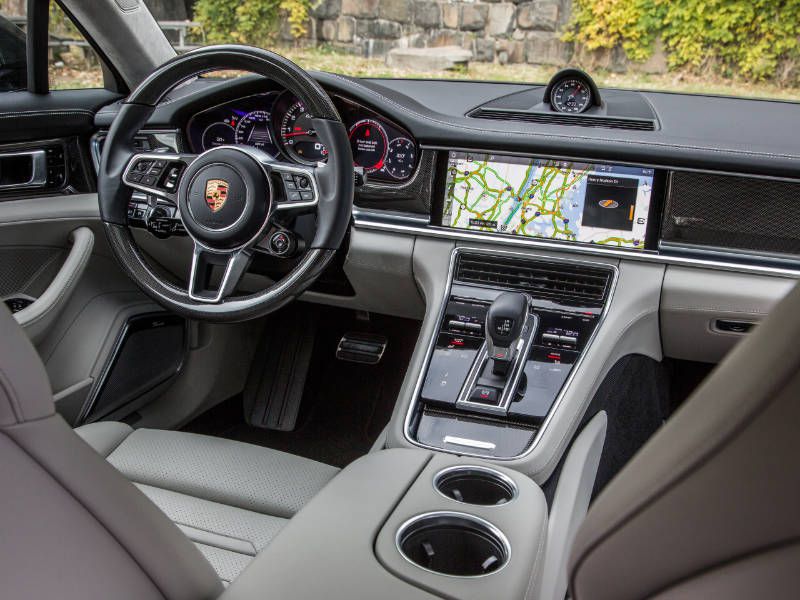
Photo by Porsche
Smaller Trunk Then an S-Class
Cargo space isn’t exactly commodious. The Panamera offers about the same trunk space as Porsche's Macan compact SUV. The standard Panamera hatchback offers 17.6 cubic feet of trunk space, which expands to 47.3 cubic feet when you fold its rear seat. The Panamera Executive has the same 17.6 cubic feet, but its longer wheelbase adds about 5 inches of rear legroom and also expands the cargo volume to 52.6 cubic feet when you fold its rear seat. The trunk of a Mercedes S-Class offers 18.7 cubic feet.
The taller roof of the Sport Turismo adds some space, but not very much. It offers 18.3 cubic feet with the backseat up and a maximum of 49 cubic feet of space. The E-Hybrid loses a few cubic feet of trunk space to house its battery pack.
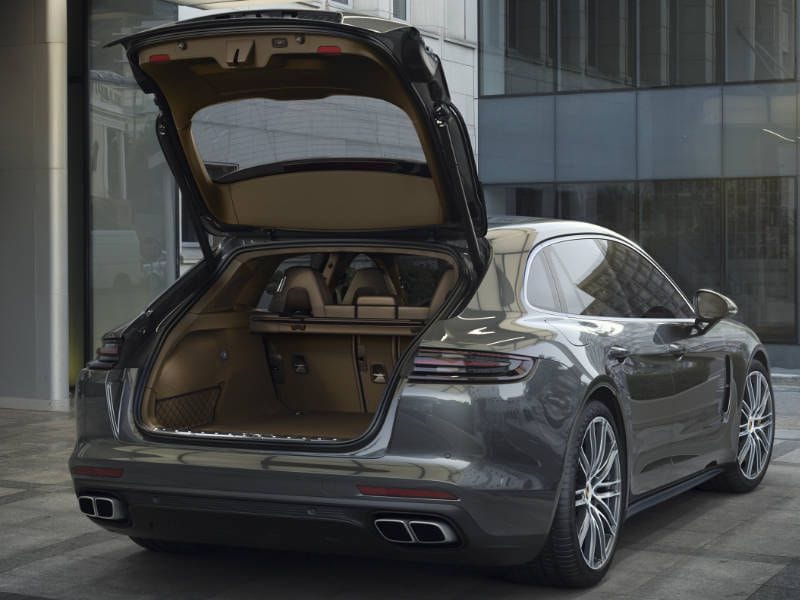
Photo by Porsche
Optional Advanced Safety Systems
Despite its $104,000 base price, our 2018 Porsche Panamera 4S didn’t have many standard driver aids, though our test vehicle did come standard with rain-sensing windshield wipers, a backup camera, and front and rear parking sensors.
Our car's surround-view monitor, which gives the driver a 360-degree bird’s-eye view of the vehicle at low speeds, was an extra-cost option. So were its night vision, lane-keep assist, adaptive cruise control and blind-spot monitor. Rear cross-traffic alert is not available.
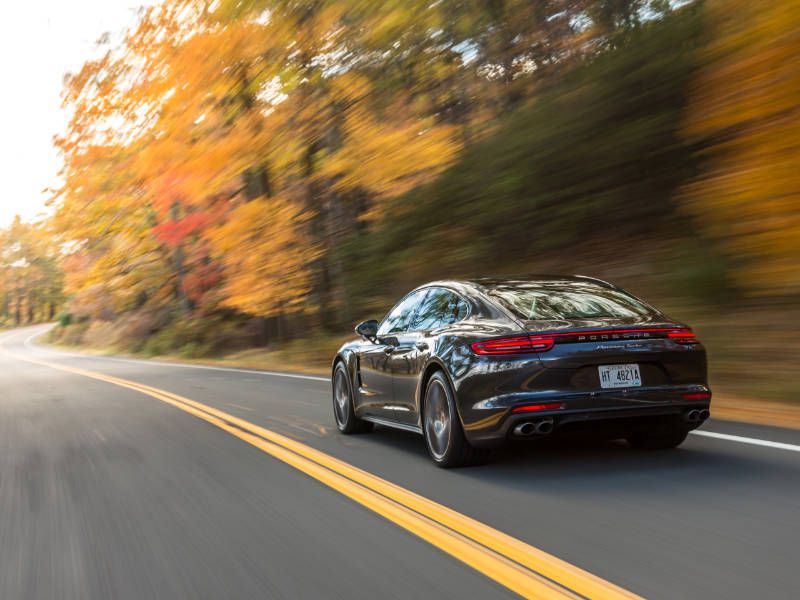
Photo by Porsche
Final Thoughts
If you’re looking for a sporty full-size luxury sedan, the 2018 Porsche Panamera is an extremely desirable overall choice. It delivers one of the finest driving experiences in the luxury sedan class, it’s much more fun to drive than a Mercedes S Class or BMW 7-Series, and its choice of body styles is unique in the class.
The Porsche’s short list of standard safety technology will surely turn off some buyers, but the Panamera is one of the best cars in the world and it’s worth its steep sticker price.
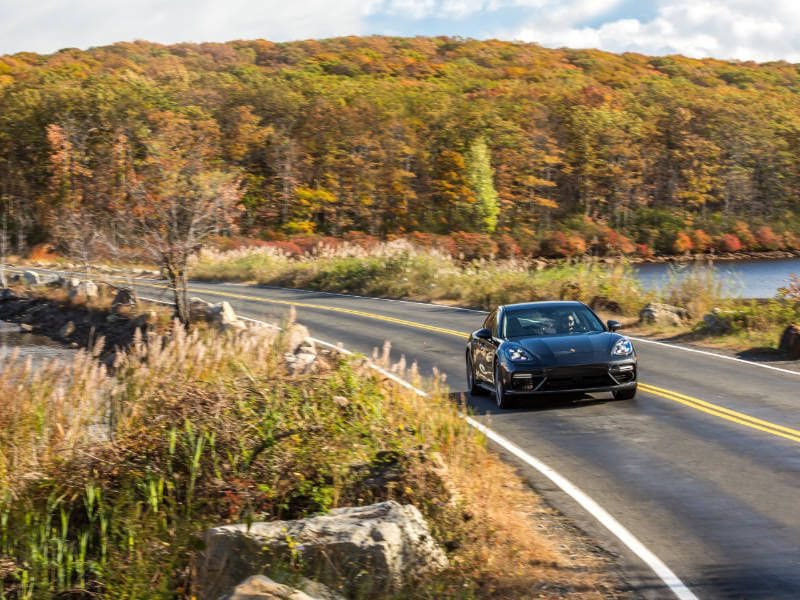
Photo by Porsche